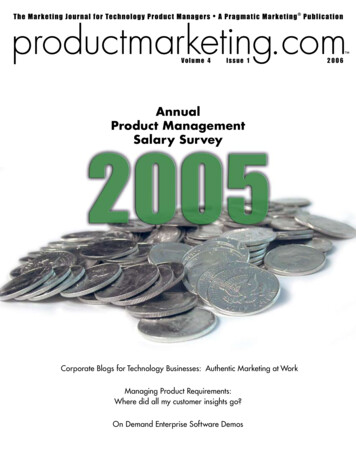
Transcription
Vo l u m e 4Issue 1AnnualProduct ManagementSalary Survey Corporate Blogs for Technology Businesses: Authentic Marketing at WorkManaging Product Requirements:Where did all my customer insights go?On Demand Enterprise Software Demos2006
Deliver softwarethat fits each oneof your customersperfectly.Provide a great customer experience and watch yourrevenue grow.With FLEXnet Publisher you can exceed your customers’ expectations: not only canyou quickly change software pricing and licensing terms for your products, you canmake software licensing and activation an invisible part of the user experience. Theresult is software that fits customer needs—exactly.As the industry standard in software licensing solutions, FLEXnet Publisher is partof Macrovision’s FLEXnet platform—the leader in software value management.To learn more, visit www.macrovision.com/pmCopyright 2005 Macrovision Corporation and/or Macrovision Europe Ltd. All Rights Reserved. Macrovision and FLEXnet are registered trademarks ofMacrovision Corporation. All other trademarks are the property of their respective owners.
productmarketing.comInside this issue: 16035 N. 80th Street, Suite FScottsdale, AZ 85260Volume 4President and CEOCraig StullPragmatic Marketing, Inc.Issue 1 2006Managing EditorKristyn BenmoussaContributing WritersJake AdgerRob BernshteynTed HartnellSteve JohnsonDavid Meerman Scott4 Pragmatic Marketing’s AnnualProduct Management Salary SurveyEach year we conduct a survey ofproduct managers and marketingprofessionals to bring you informationabout compensation as well as the mostcommon responsibilities for product managers.Here are the results for 2005!Interested in contributing an article?Email submissions tokbenmoussa@pragmaticmarketing.comBLOGNo part of this publication may be reproduced,stored in any retrieval system, or transmitted, inany form or by any means, electronic, mechanicalphotocopying, recording or otherwise, withoutthe prior written permission of the publisher.productmarketing.com is available free ofcharge to qualified subscribers. For subscriptionor back issues call (480) 515-1411; or visitwww.PragmaticMarketing.com/subscribe/To be removed from the mail list, visitwww.PragmaticMarketing.com/unsubscribe/or send an email to info@PragmaticMarketing.comFor advertising rates, call (480) 515 -1411.Other product and/or company names mentionedin this journal may be trademarks or registeredtrademarks of their respective companies andare the sole property of their respective owners.productmarketing.com , a Pragmatic Marketing, Inc.publication, shall not be liable regardless of thecause, for any errors, inaccuracies, omissions, orother defects in, or untimeliness or unauthenticityof, the information contained within this magazine.Pragmatic Marketing makes no representations orwarranties as to the results obtained from the useof this information. Pragmatic Marketing does notwarranty or guarantee the results obtained fromthe use of this information and shall not be liablefor any third-party claims or losses of any kind,including lost profits, and punitive damages.productmarketing.com is a trademarkof Pragmatic Marketing, Inc.Printed in the U.S.A.All rights reserved.8 C orporate Blogs for Technology Businesses:Authentic Marketing at WorkT here are many ways to market your companyon the web. Now we have another importantalternative: the Corporate Weblog (blog).16 Managing Product Requirements:Where did all my customer insights go?Here are some of the most important questions that product managersface every day. This article illustrates how Requirements Managementnot only helps your company deliver more customer-driven productsbut how it helps you personally work more efficiently.22On Demand Enterprise Software DemosNobody can argue the value of delivering a super compellingdemo. But how? One common theme is that a top-quality demonstrationshould not simply list product features and functions but should grabthe audience’s attention by speaking directly to business issues.28C ase StudyNetContinuum Knows WhichMarketing Programs AreMost EffectiveAbout Pragmatic Marketing, Inc.Pragmatic Marketing, Inc. was formed in 1993 toprovide product marketing training and consultingto technology firms by focusing on strategic,market-driven techniques. Pragmatic’s trainingcourses emphasize business-oriented definitionof market problems, resulting in reduced risk andfaster product delivery and adoption. Since itsinception, Pragmatic Marketing has successfullygraduated over 30,000 product managers andmarketing professionals. For more information, visitwww.PragmaticMarketing.com or call (480) 515-1411.productmarketing.com Volume 4, Issue 1, 2006
Pragmatic Marketing’sAnnualProductManagementSalar ySur veyBy Steve Johnson productmarketing.com Volume 4, Issue 1, 2006
Pragmatic Marketing’s Annual Product Management Salary Survey 2005Each year Pragmatic Marketing conducts a survey ofproduct managers and marketing professionals. Ourobjective is to provide Pragmatic Marketing clientswith industry information about compensation aswell as the most common responsibilities for productmanagers and other marketing professionals.A total of 484 product management andmarketing professionals responded to the survey.The survey was conducted during the periodof November 7-24, 2005 using WebSurveyor. FemaleUS region ryBonusTotalMidwest 73,211 6,500 79,711 90,280 10,500 100,780 82,909 9,088 94,41412,826107,240OverallAverage 85,414 10,857 96,271 93,516 10,976 104,492 90,610 10,961 101,571Canada ,048(2) C anada amounts requested in U.S. .We did not receive adequate responses fromother countries to report statistically valid data.(1)Midwest (IA, IL, IN, KS, MI, MN, MO, ND, NE, OH, SD, WI)Northeast (CT, DE, MA, ME, NH, NJ, NY, PA, RI, VT)Pacific (Alaska, CA, Hawaii, OR, WA)South (AL, FL, GA, KY, MD, MS, NC, SC, TN, VA, WV)Southwest (AR, LA, OK, TX)West (AZ, CO, ID, MT, NM, NV, UT, WY)In 2001, 29% wrote specs, today 52% write specs.And back in 2001, 50% were in the marketing dept.but today 15% are in the marketing dept.productmarketing.com Volume 4, Issue 1, 2006
Pragmatic Marketing’s Annual Product Management Salary Survey 2005Profile of a product managerImpacts on productivity The average product manageris 36 years old Product managers receive 50 emailsa day and send about 25 87% claim to be “somewhat”or “very” technical Product managers spend roughlytwo days a week in internalmeetings (15 meetings/week) 90% have completed college and 46%have completed a masters program 33% are female; 67% are male The typical product manager hasresponsibility for three products But 50% are going to 15 meetingsor more each week, and 27%attend 20 or more meetings!Working with MarketingCommunications and SalesProduct managers also spendtime providing technical contentfor Marketing and Sales. 49% writing promotional copy 23% creating web content 47% approving promotional materialsWorking with Development 16% working with press and analysts 51% training sales peopleThe typical product manager reports toa director in the marketing department.The majority of product managers areresearching market needs, writingrequirements, and monitoringdevelopment projects. 46% report to a director 66% researching market needs 28% report to a VP 54% preparing business case 5% report directly to the CEO 19% performing win/loss analysisAverage U.S. product managementcompensation is 90,610 salary plus 10,961 annual bonus (79% ofproduct managers get a bonus). 15% are in the marketing department 79% monitoring development projects 21% are in the productmanagement department 77% writing requirements(the “what” document) 12% are in Developmentor Engineering 52% writing specifications(the “how” document)Organization 5% are in a sales departmentSteve Johnson is an expert in technology product management.He works for Pragmatic Marketing as an instructor for the top-ratedcourses Practical Product Management and Requirements That Work aswell as onsite courses. Contact Steve at sjohnson@PragmaticMarketing.com productmarketing.com Volume 4, Issue 1, 2006 44% going on sales callsCompensationOur bonuses are based on 60% company profit 32% product revenue 41% quarterly objectives (MBOs)Almost 37% say the bonus does notmotivate at all and only 12% say thebonus motivates a lot.
[Do your developers have a clear direction?]think with the grid. Pragmatic Marketing has always been focused on the uniquechallenges of marketing technology products and services.The framework we teach—refined and perfected over20 years—highlights both “best practices” and practicalones to find and develop profitable opportunities, planmarket-driven products, and create winning promotionaland sales campaigns. Each seminar offers immediateactionable ideas, templates, and tools.Visit www.PragmaticMarketing.com to learn more.The Industry Standard in Technology Product Management and Marketing Education.
CorporateBlogs forTechnologyBusinesses:AuthenticMarketingat Work productmarketing.com Volume 4, Issue 1, 2006By David Meerman Scott
The rules for reaching your buyers through online communications havechanged dramatically. Most marketers know and use several ways totell their story on the web: email marketing and newsletters, through themedia (hoping that online reporters write good things) or via a company’smarketing communications website. While these tools are important, nowwe have another important alternative: the Corporate Weblog (blog).Blogs are one of the few formsof marketing that, done well,are considered authentic thoughtleadership by the market. Rather thanthe egocentric product informationthat appears on most technologycompany websites, blogs providevaluable information about a marketor topic for people in all stages of thesales cycle. However, for marketersraised on the notion of journalism asa craft demanding a fair and balancedview of a topic, the leap to bloggingcan seem daunting. In journalismschool, aspiring reporters and editorsare taught that stories are developedthrough research and interviewswith knowledgeable sources. And foryears, public relations and marketingprofessionals have worked exclusivelythrough journalists to get their storiestold. But the online conversationhas shifted to allow anyone with akeyboard, an interesting point ofview, and the guts to start a blogthe possibility of equal voice.Forward thinking technologycompanies are creating blogs todirectly reach buyers. In a reportcalled The State of Blogging releasedby the Pew Internet & American LifeProject, blogs are used by millionsof people and the growth rate isextraordinary. Two Pew surveysconducted in early 2005 show that16% of U.S. adults (32 million) areblog readers (a 58% increase from2004). Perhaps the most interestingpart of the Pew study is that 6% ofthe U.S. adult population has createda blog (that is 11 million peopleor one out of every 17 Americans).And according to Technorati ,a popular blog search engine,in its State of the Blogospherereport issued in mid-2005, a newblog is created every second.Blogging basics: What youneed to know to get startedTechnology marketing professionalsoften struggle with what to blogabout. The first thing to consider is“who do I want to reach?” For manypeople, the answer is a combinationof buyers, existing customers andinfluencers such as analysts and themedia. For a blog to be valuable tothis kind of audience, the contentneeds to focus on an issue in themarketplace and not just on yourcompany and its products. Thinkabout a definable area where yourcompany has expertise. For example,if your company sells CRM software,you might do a blog on sales forceeffectiveness. What can you say aboutyour market that identifies youas an undisputed thought leader? productmarketing.com Volume 4, Issue 1, 2006
Corporate Blogs for Technology Businesses: Authentic Marketing at WorkA Sampling of Corporate Blogsfrom Technology CompaniesYale Tankus, vice president of Alliances andPartnerships for HP’s management softwarebusiness (HP ve Goldstein, CEO of Alacrawww.alacrablog.comAlan Meckler, CEO of rCisco Worldwide Government Affairs’High Tech Policyhttp://blogs.cisco.com/gov/Simplicity from Cincom peak from EnvironmentalSystems Corporationhttp://www.plantspeak.com/Read Between the Mines: A text miningblog from Glenn Fannick, a ProductDevelopment Manager at Factivahttp://www.fannick.blogspot.com/Most first-time bloggers try to covertoo much. It is better to start witha narrow subject and leave room toexpand. Be authentic. People readblogs because they want to find anhonest voice speaking passionatelyabout a subject. You do not have tobe harsh or controversial if that is notyour style. If you are interesting andprovide valuable information, yourreadership will grow. Before you begin,think carefully about the name ofyour blog and the tagline, which willbe indexed by the search engines.Some organizations have created formalguidelines for employee bloggers.The decision to create guidelines issomething that is personal to your owncompany’s situation and should bedetermined based on the input fromMarketing, HR, and other departments.It is always better to avoid passingindividual blog posts through yourPR or legal teams. However, ifyour blog posts must be reviewed byothers in your organization beforegoing live, then have your colleaguesfocus on the content, not your actualwords. Do not let PR people turn theauthentic content in your blog intoanother form of “MarCom copy.”Blogging technology:Easy and inexpensiveUnlike websites that require designand HTML skills, off-the-shelf blogsoftware offers rapid set-up andeasy-to-use features. With basicknow-how, you can quickly and easilyestablish and promote your blog. Easy-to-use blogging services areavailable from Blogger , TypePad ,WordPress, and others. Research theservices based on your needs andchoose wisely because it is difficult toswitch once your blog is established. You will need to choose a URLfor your blog. The bloggingservices all offer a URL that youcan customize (such as yourblog.typepad.com). You can also mapyour blog to your company’s domain(www.yourcompany.com/yourblog) ora custom domain (www.yourblog.com). 10 productmarketing.com Volume 4, Issue 1, 2006 Blogging software makes it easyto choose color, design, font, and tocreate a simple text-based masthead.You might consider a customgraphical image as your masthead. The look and feel of the blogshould be complementary toyour corporate design guidelines,but it need not be identical. Blogging software usually allowsyou to turn on a commentsfeature so your visitors are ableto comment on your posts. RSS (Really Simple Syndication) is astandard format that blog posts aredelivered in to subscribers. Makecertain that your new blog has acapability to offer an RSS feed. Standard practice is to sendan electronic “ping” to blogsearch engines and RSS readercompanies when you havea new post on the blog. Blogs play a great role in helpingto achieve high rankings in searchengine results. Smart bloggersunderstand this and use their blogsto help promote their organizationto audiences who are searchingon particular words and phrases. To build an audience, create linksto your blog from your homepage, product pages, or onlinemedia room. Mention your blogin your email newsletter or offlinenewsletters and create links to yourblog as part of your email signature.Your customers, potential customers,investors, employees, and the mediaare all reading blogs and there is nodoubt that the corporate blog is aterrific way for technology marketers totell authentic stories to the market. Butbuilding an audience for a corporateblog takes time. Most blog servicesprovide tools for measuring traffic.Use this data to learn which posts areattracting the most attention. You canalso learn what sites people are comingfrom when they visit your blog andwhat search terms they used to find you.Use this information to continuouslyimprove your blog. And don’t forget,you are the expert.
Corporate Blogs for Technology Businesses: Authentic Marketing at WorkCase Study: Blog from Environmental Systems Corporation Shows Domain ExpertiseAccording to Steve Drevik, MarketingCommunications Director forEnvironmental Systems Corporation,the company’s core competency isits domain expertise in air pollutionmonitoring. The company pridesitself on maintaining three fulltime regulatory experts to keepthe company and its customers onthe forefront of evolving EPA, state,and local regulatory requirements.This information is not alwaysclear, so interpretations and a deepunderstanding of what a particularregulatory requirement means andhow it applies to the company’sclient’s business is invaluable.Even before Drevik attendedPragmatic Marketing’s EffectiveMarketing Programs seminar hehad been plotting and schemingabout establishing a corporate blog.“I had been addicted to a coupleof blogs related to marketing anddesign for quite some time,” Dreviksays. “I saw a blog as a great wayto present our company’s domainknowledge and our position in ahighly credible manner. It was onething to say that we were the expertsin our marketing literature and ournewsletters. It was quite another toput our thoughts and our opinionsout for regulators and customersto review, criticize, and comment.The blog was clearly a greatopportunity to cement and expandour position as experts and leaders.”The first challenge for Drevikwas in selling the idea to seniormanagement. “My VP noted thatuntil I mentioned it to him, he hadnever heard the word ‘blog.’ Butover the next two weeks, he haddozens of encounters with the termon the radio, in newspaper articles,and on TV,” Drevik says. “Thetiming of my proposal was indeedfortunate. I presented the idea tothe Sales Director, and all of ourOperational Directors. Once it wasthoroughly explained, everyone wason board and saw the potential. Wewere clearly charting new waters ina company with a history of veryconservative and limited marketing.”Creating PlantspeakDrevik says that one of his greatestchallenges was naming the blog. “Wehad to return to the drawing boardseveral times, a challenge familiarwith anyone who has to developnew product names or logos,” Dreviksays. He chose the name Plantspeakand also was able to secure thedomain name (www.plantspeak.com).Drevik went through a number ofblogs and found features that he feltwould be key to his blog, such as aneasy way for readers to find specificarticles of interest. “We settled onthe Scoop blog engine, which allowscategorization of articles, as well asthe ability for readers to create theirown ‘clippings’ of particular articlesof interest to them,” Drevik says.“Scoop also allows for easy creationof polls, either associated with themain site or with individual articles.”Environmental Systems Corporationlaunched the Plantspeak blog at alarge trade show using giveawaysand a tag line: Hear What OthersAre Saying. “Within two weeks, wehad over 100 outside registrants, orroughly a quarter of the conferenceattendees,” Drevik says. “Thatnumber quickly rose to over 300with some more email promotion,good for our niche industry,where the biggest trade showbrings in about 500 attendees.”Drevik says that while he hasmore work to do to build up hisreadership, the response so far hasbeen very positive. He has continuinggoals for the blog in the company’smarketing plan including crosslinking and cross-promotion from thecompany’s website (www.envirosys.com). He is clearly enthusiastic abouthis blog and offers suggestions foranyone considering taking the leapinto the blogosphere. “Focus on yourcore competency as it relates to thecustomer,” he says. “The blog shouldnot be a blatant marketing tool topromote your company. Use theblog to provide information usefulto their daily jobs, with embeddedlinks as appropriate to what youdo within your own website. Andlike any website, promotion andreadership take time. Be patient.”productmarketing.com Volume 4, Issue 1, 2006 11
Corporate Blogs for Technology Businesses: Authentic Marketing at WorkCase Study: Factiva’s Text Mining Blog Highlights InnovationGlenn Fannick, a Product Development Manager at Factiva , a DowJones & Reuters Company, started his blog “Read Between the Mines”(http://www.fannick.blogspot.com/) as an experiment. “My job at Factivahas me working on products that help enterprises monitor blogs, so I thoughtI should know what it is like to be on the side of the author,” Fannick says. “Ithas helped me focus on my topic area, given me a creative outlet, and maybeeven given Factiva a bit more credibility in the topic on which I write.”Fannick blogs about a very specific subject area: text mining and media monitoring.“It has helped me to stay on top of the developments in the industry,” he says.“But more than that, it helps me to develop my ideas and challenge myself morethan would happen if I just read a trade journal about the topic. My blog is alsoa good way of connecting with Factiva’s client-facing staff around the world. I’vereceived emails from sales staff in other offices who read the blog and had ideasrelated to their regions. So it is a good internal communications tool too.”Fannick sees his blog as an important way to humanize what he does. “Businessfocused blogs can be a very effective way for a company to ‘show off’ its humanresources,” he says. “I think many of Factiva’s clients stay Factiva clients becauseof the people behind the products. We strive to be open with our clients andblogging is another great way to do that.” He has also utilized the interactivenature of the medium. “Blogging is conversing and often times I have founda conversation starts by reading someone else’s post, commenting on his orher site and then going back to my site and writing more about it,” he says.“Many people don’t have much interesting to say,” Fannick cautions. “Samething goes for companies. If you are in a sector that does not lend itself to opendialog or competes mostly on price and not on service or innovation, then theremight not be much to talk about. There is really no reason to write a blog ifyou cannot envision the type of person who would have interest reading it.” Heoffers sound advice for technology companies considering a blog: “A companyprobably has to dare to be a different and willing to take some risks. If yourcompany does everything by committee or has to have everything signed offby five levels of executives, your blog will end up reading like your corporatehome page or your marketing material—overwritten and uninteresting.”David Meerman Scott is an instructor for the Pragmatic Marketing Effective MarketingPrograms seminar and author of the new book Cashing in with Content: Howinnovative marketers use digital information to turn browsers into buyers.Check out his blog at www.WebInkNow.com 12 productmarketing.com Volume 4, Issue 1, 2006
Ask the ExpertAfter 25 years working for a number of software and hardware companies I’ve noticed that therehas been seepage of the product management function into Sales and other parts of the company.Is there any way to change a culture that is deeply rooted on “we do what Sales says because weneed to make the sale or we do what Development says because this is a technical organization”?I encounter those organizationsall the time: revenue or technologydriven organizations who don’tvalue product management. Theseare often the very organizationswe see in the news—in bankruptcy.Most companies only reallyunderstand product managementwhen the company starts to fail.But getting senior managementsupport for product managementis often a huge challenge—withonly one answer: use market factsto make all product decisions.Alas, it’s easier said than done.tech-driven startsThere is a huge pretension onthe part of engineers (and oftenthe founder of your company,who was an engineer), whosay, “I am brilliant. I havecome up with a technologyproduct and everybody willwant it. All we need to donow is find customers.”These companies quickly reachsome level of success and theycan’t push past it. They’ve beenat ten million dollars for a decade,and they’ve had a bunch of newproducts and none of them havedone well, and finally they thinkthat maybe product managementis the answer. It’s just too hardto build and maintain a companyon technology alone. ProductManagement gets involved insaving the company when theother avenues have failed.tech-driven endssales-driven startsThere are organizations whereyou watch their stock fall andif you interview any of theiremployees, they say “wow, wethought the sales people werethe customer and now our stockhas tumbled to 2 and we don’tknow how it happened.” But thefailure was easy to predict: salespeople are not the customer andthe more we listen to them themore likely it is we will bankruptthe company. Sales people arefocused on the three deals they’reworking—which is exactly whatwe want from them. But we don’twant to rely on these short-termfocused employees for longterm product strategy. In fairnessto sales people, their VP hasencouraged this behavior. TheVP of Sales doesn’t believe in allthat tedious planning and ivorytower thinking that ProductManagement is doing; a “deala day” is his success formula.It’s just the way sales peopleare wired and that’s why growthcompanies look elsewherefor strategy. Revenue drivencompanies focus on the quarterto the detriment of next year.The solution is for ProductManagement to be representativesof markets and not deals. Finda problem in a market segmentand ensure that the segmentis big enough to generate aprofit. Deliver this informationto the senior executive teamin a business case that combinespersonal customer experiencewith quantified market research.Sell the value of the long-term view.Once a path is determined, keepup the communication. Don’tcover over the problems andhope you won’t miss the datesbecause you surely will. Whenthe company accepts a dealthat pulls developers from yourproject, make sure the seniorexecutive team understands thatthey have delayed the deliveryof your project. When a developeradds a “neat” feature whilerefusing to work one that we’veagreed to, tell management. Ineffect, tell them that the companyis deviating from their plan andmake sure they’re happy about it.But they should be furious wheneither sales people or developersderail agreed-upon plans.sales-driven endsSteve Johnson is an expert in technology productmanagement. He works for Pragmatic Marketing asan instructor for the top-rated courses Practical ProductManagement and Requirements That Work as wellas onsite courses. Contact Steve at m Volume 4, Issue 1, 2006 13
isitionMarketResearchProductPerformanceBuy, Buildor rainingPresentations& DemosUseScenariosSuccessStoriesCollateral &Sales ICPragmatic Marketing Seminars 1993-2006 Pragmatic Marketing, Inc.think with the grid. The recognized expert in technology product management and marketing,Pragmatic Marketing’s common sense approach is built on years of experience andbest practices. The Pragmatic Marketing seminars introduce a framework thatgives technology marketers the tools necessary to deliver market-driven productsthat people want to buy. Our framework is the foundation for all our courses,from identifying markets and their problems to writing market requirementsto creating go-to-market strategy that meets your corporate and revenue goals.Since 1993, over 30,000 attendees have been trained to “think with the grid.”The Industry Standard in Technology Product Management and Marketing Education.
Complete Curriculum for Technology MarketersPractical ProductManagement Practical Product Management isfor product managers and thosewho manage or contribute toaspects of product marketing andmanagement. This two-day seminarfully explores the role of technicalproduct management, providingtools and a framework to help getproducts to market more efficiently.Complete seminaragendas are available atwww.PragmaticMarketing.comDAYS 1 – 2I. Strategic Role of Product Management What is marketing?Definition of the role of product managementContrasting product management and product marketingAssigning ownership of responsibilitiesIdentifying the “first steps” with gap analysisII. Market Analysis Distinctive competenceMarket researchMarket problemsTechnology assessmentCompetitive analysisIII. Quantitative Analysis Market sizingProduct performanceOperational metricsWin/loss analysisIV. Product Strategy Business casePricingBuy, build, or partner?Thought leadersInnovationctal ProduictcarPsureStill not ment is for you?.Managesessiony1/2-daEERils.Faor detafrAttendevock cSee baV. Product Planning Positioning Sales processVI. Case StudyVI
Pragmatic Marketing's Annual Product Management Salary Survey 2005 Steve Johnson is an expert in technology product management. He works for Pragmatic Marketing as an instructor for the top-rated courses Practical Product Management and Requirements That Work as well as onsite courses. Contact Steve at sjohnson@PragmaticMarketing.com











